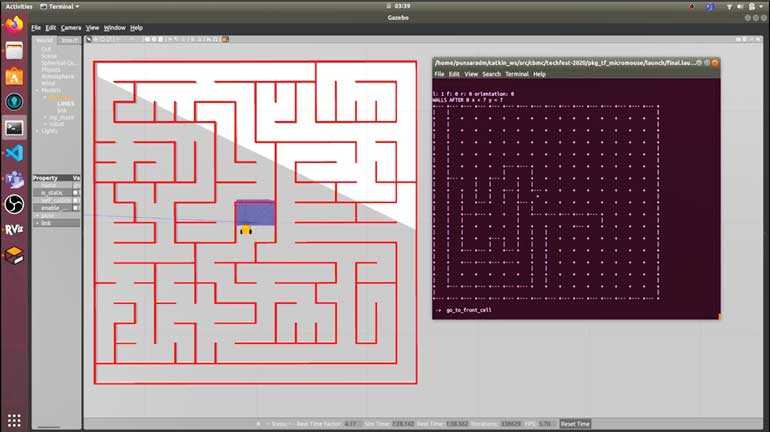Sunday Apr 20, 2025
Sunday Apr 20, 2025
Tuesday, 19 January 2021 01:01 - - {{hitsCtrl.values.hits}}

Gone were the days we needed hardware to build a robot. In an era of virtual robotic competitions, it is high time for the Sri Lankan student community to embrace this new paradigm of robotics
 Year 2020 was not the year that we all had dreamt of, yet it had its own blessing for us. Specifically, for us in Sri Lanka, it has revolutionised the way that we perceive education.
Year 2020 was not the year that we all had dreamt of, yet it had its own blessing for us. Specifically, for us in Sri Lanka, it has revolutionised the way that we perceive education.
Though the new-found avenues have their own ups and downs, now a majority of the students both in schools and universities are adapted to continue their studies online. But, when it comes to robotics, you might doubt about the possibility of learning online as it is intertwined together with the hardware components.
Whether you are aware of it or not, there are a number of platforms available for us to learn robotics from its very basics to building complex robotic systems. Even there was a local competition, IESL RoboGames, in Sri Lanka which promoted this paradigm of robotics.
In the past few years there were as much as 10 competitions organised in the country to encourage the eager young minds to pursue robotics. They have played a major role to create enthusiasm among the youth of our country to be creative and innovative.
Though the current challenges have discouraged us to follow the conventional paths of the last few years, we should keep addressing these challenges and continue promoting robotics in the student community as the skillset gained from learning robotics will drive innovation paving the path for Sri Lanka to shine bright in the world.
The familiarisation with online education in Sri Lanka is the best encouragement that we have received to learn robotics without depending on hardware. Lack of dependency on hardware will encourage the student community as the cost of hardware is also one of the downsides in robotics. Since the students are having ample time, robotics has the potential to become the new-found hobby of the youth.
Challenges faced in learning robotics.
The biggest concern of robotics compared to learning programming or something else is that it is impossible to neglect the hardware components and the hands-on experience which is fundamental. Most of the hardware component stocks in Sri Lanka is almost over and some of the components are hard to find due to the imposed import restrictions. Furthermore, financial difficulties come into play as building a robot from scratch requires accessories such as batteries, chargers and basic tools.
Another concern of COVID-19 in terms for the robotic enthusiasts is not being able to participate in robotics competitions. It is the most effective way to learn and enhance one's knowledge. International competitions like Robocon had to be cancelled this year and many other major competitions were postponed.
With adaptation to modern online teaching platforms like Zoom, one can argue that robotics can also be taught online. It is true for the theoretical aspect in robotics, but no proper complete education can be achieved without the practical sessions and evaluations.
Further, looking from Sri Lanka’s perspective most students still learn about line following robots which were founded back in the 1970s while students from elsewhere learn about self-driving cars and play with humanoid robots. Therefore, it is evident that there is a paramount gap between the local and international robotics and it should be addressed effectively.
Solutions
In this article, the main intention is to propose effective solutions to address these common challenges faced in learning robotics. Theoretical aspects can be covered by simply watching YouTube videos and following many online courses. But the lack of trust towards the tutor and being not able to get the questions answered are the major drawbacks.
To overcome these, our initiative ‘CircuitBreakers Robotics’ has started to create free online content with the vision of empowering robotics education in Sri Lanka and our ‘CircuitBreakers Robotics’ community on Facebook provides the opportunity to any individual to get their questions answered by the experts in the field.
To cover the practical aspect, we have identified some commonly available platforms which can be used to overcome some of the challenges mentioned above by simulations. These platforms can be mainly categorised into three main categories:
1. Online platforms
2. Offline platforms
3. Hybrid platforms
Online simulation
Newbies and someone who wants to just have a glimpse in robotics can benefit from these platforms as there is no cost incurred in terms of hardware. When we first learn something new, we make lots of mistakes and if those mistakes are done in a simulated environment it is easier for us to correct than toying with physical hardware.
When it comes to simulations, there are a bunch of professional simulation tools. But the focus here is to have more user friendly, simple, and easy learning platforms. Out of these, with experience of conducting many free webinars online we have identified "Tinkercad" by Autodesk as one of the most effective platforms to begin with.
Tinkercad platform is a free platform which supports simulations using both text based and visual programming environments. It supports all-time favourite “Arduino’ and ‘Microbit’ programming styles. Basic boards such as Arduino UNO board with several sensors and actuators are built-in to get started. It supports for both students and tutors. The tutors can create separate accounts where they can create classrooms and assign students to these classrooms to check the activity of these students and to check their submissions.
We are humble to state that we are the first in Sri Lanka to introduce the Tinkercad platform to Sri Lankan students through our free robotics webinars conducted online. This solution addresses many problems mentioned above. You can visit Tinkercad website to find out more details and getting started. (https://www.tinkercad.com)
Offline simulation
For those who would like to take this to the next level and step into real-world simulations there are offline simulation platforms that can provide higher graphics. But these platforms require high performance computers to run the simulations.
1. Webots
Webots is an open-source platform which was founded in 1996 which is currently developed by Cyberbotics Ltd. We can write programmes in most of the common programming languages like C++, Python, JAVA and Matlab. This software can provide realistic fast simulations which can be used in many applications like fast prototyping of wheeled and legged robots, multi-robot simulations, research on robot locomotion, and most importantly to host robotics competitions.
It is wonderful to see that a competition recently organised by IESL IT and Communication Engineering Sectional Committee in collaboration with University of Moratuwa Computer Science and Engineering Department, ‘IESL Robogames 2020,’ was hosted using the Webots platform. In this competition our own team ‘CircuitBreakers’ was able to successfully secure the championship. This software can be installed in many platforms like MacOS, Windows and Ubuntu. You can visit their official website to find out more. (https://cyberbotics.com)
2. Robot Operating System (ROS)
This is the favourite simulation environment for most of the industrial robotics applications. This is used literally in every robot to control its hardware, path planning and localisation purposes. It is also open source like Webots, and its latest version is ROS 2. It is mostly used in Linux and Ubuntu environments while it has limited support for Windows and MacOS. The famous Gazebo and RViz packages are used for the simulation purposes. ROS can be used to host robotics competitions too.
Recently our team ‘CircuitBreakers’ won the second Runner Up award at the first ever International Micromouse Challenge hosted using this platform by IIT Bombay in Techfest 2020, which is Asia's largest Science and Technology Festival. Here, the simulation is done through a maze built inside ROS using Gazebo environment and RViz. You can find lots of resources by heading into ros.org.
Hybrid simulation
The major drawback in offline systems is the high-performance requirement of the host computer, which is challenging for the student community in Sri Lanka. There are solutions that combine the best of both worlds and even embedding real hardware into the system, hybrid simulation.
Technologies of cloud computing has already solved these problems for common application deployment by enabling users to buy server instances to a reasonable cost. What if we can get an instance of ROS for a one week for a reasonably price as we buy virtual cloud computers? There are solutions out there already that brings these into reality.
A Switzerland based company called the "constructsim” have partnered with the biggest education providers to make this service available. It has both a free membership with limited access and a paid membership. This solution enables a student to learn robotics independently of his computer’s operating systems and performance.
Also taking this further, you can purchase a time slot to control a real robot where you can see how the robot behaves through the camera feed and send control messages through a Virtual Private Network (VPN). To find out more drop by their official website. (https://www.theconstructsim.com)
Conclusion
This is a long-awaited opportunity for students to learn robotics effectively amid COVID-19 adapting to the limitations and challenges we must go through. It is also a valuable chance for the education system to take advantage of such systems to effectively conduct online education.
Also, as a country it is high time to align with the international standard of robotics. Robotics as it engages all senses helps to build teamwork, creativity, and innovation among the youth. Therefore, these youngsters will be more creative than ever which will drive us forward as a nation.
It is better to start off with a low risk by using simulation tools as a first step. After the fundamentals are covered one can go further and play with physical hardware. Even though we have presented lots of solutions that are currently available we always encourage you to first try one or two platforms and try to have thorough understanding.
Finally, we hope this article may enlighten you with learning robotics while facing challenges. A journey of a million steps begins with the first step. Therefore, let us start to learn robotics today. Happy time building robots!

A circuit created using Tinker CAD

The maze solve competition – IESL Robogames 2020

The micromouse competition simulation – IMC, Techfest 2020
Discover Kapruka, the leading online shopping platform in Sri Lanka, where you can conveniently send Gifts and Flowers to your loved ones for any event including Valentine ’s Day. Explore a wide range of popular Shopping Categories on Kapruka, including Toys, Groceries, Electronics, Birthday Cakes, Fruits, Chocolates, Flower Bouquets, Clothing, Watches, Lingerie, Gift Sets and Jewellery. Also if you’re interested in selling with Kapruka, Partner Central by Kapruka is the best solution to start with. Moreover, through Kapruka Global Shop, you can also enjoy the convenience of purchasing products from renowned platforms like Amazon and eBay and have them delivered to Sri Lanka.
Discover Kapruka, the leading online shopping platform in Sri Lanka, where you can conveniently send Gifts and Flowers to your loved ones for any event including Valentine ’s Day. Explore a wide range of popular Shopping Categories on Kapruka, including Toys, Groceries, Electronics, Birthday Cakes, Fruits, Chocolates, Flower Bouquets, Clothing, Watches, Lingerie, Gift Sets and Jewellery. Also if you’re interested in selling with Kapruka, Partner Central by Kapruka is the best solution to start with. Moreover, through Kapruka Global Shop, you can also enjoy the convenience of purchasing products from renowned platforms like Amazon and eBay and have them delivered to Sri Lanka.